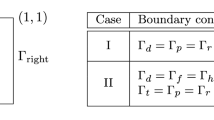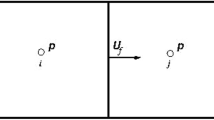Abstract
Richards’ equation is often used in unsaturated flow problems and has a wide range of applications. In the numerical solution, the Richards’ equation is linearized first, and then the finite difference method is used for numerical discretization and iterative calculation. The traditional iterative methods such as Jacobi, Gauss–Seidel (GS) and SOR iterative methods have a slower convergence rate, especially when the discrete space step is small and the time step is large. Therefore, we adopt the integral correction method and the multistep preconditioner to improve the traditional iterative methods and propose an improved Gauss–Seidel iterative method (ICMP(m)-GS) with multistep preconditioner based on the integral correction method to solve the linear equations derived from linearized Richards’ equation. Through examples of unsaturated flow, convergence rate and computational accuracy of the proposed algorithm are validated by comparing the traditional methods and analytical solutions. The results show that the proposed ICMP(m)-GS can greatly improve the ill-condition of linear equations. Compared with the conventional methods GS, SOR and a single improvement method, ICMP(m)-GS has a faster convergence rate, higher calculation efficiency and calculation accuracy. The application example shows that the proposed method can also well simulate the time-varying law of pressure head in the rainfall infiltration of unsaturated soil slopes, and has a nice application effect.




















Similar content being viewed by others
Data availability
All data generated or analyzed during this study are included within the article.
References
An K, Kim S, Chae T, Park D (2018) Developing an accessible landslide susceptibility model using open-source resources. Sustainability 10(2):293
Arioli M, Scott J (2013) Chebyshev acceleration of iterative refinement. Numerical Algorithms 66(3):591–608
Benzi M (2002) Preconditioning techniques for large linear systems: a survey. J Comput Phys 182(2):418–477
Both JW, Kumar K, Nordbotten JM, Radu FA (2018) Anderson accelerated fixed-stress splitting schemes for consolidation of unsaturated porous media. Comput Math Appl 77:1479–1502
Celia M, Bouloutas E, Zarba R (1990) A general mass-conservative numerical solution for the unsaturated flow equation. Water Resour Res 26:1483–1496
Chávez-Negrete C, Domínguez-Mota FJ, Santana-Quinteros D (2018) Numerical solution of Richards equation of water flow by generalized finite differences. Comput Geotech 101:168–175
Dehghan M, Mohammadi-Arani R (2016) Generalized product-type methods based on bi-conjugate gradient (GPBiCG) for solving shifted linear systems. Comput Appl Math 36(4):1591–1606
Durbin T, Delemos D (2007) Adaptive underrelaxation of picard iterations in ground water models. Ground Water 45(5):648–651
Fahs M, Younes A, Lehmann F (2009) An easy and efficient combination of the mixed finite element method and the method of lines for the resolution of Richards’ equation. Environ Model Softw 24(9):1122–1126
Farthing MW, Ogden FL (2017) Numerical solution of Richards’ equation: a review of advances and challenges. Soil Sci Soc Am J 81(6):1257–1269
Gardner WR (1958) Some steady-state solutions of the unsaturated moisture flow equation with application to evaporation from a water table. Soil Sci 85(4):228–232
Golub GH, van Loan CF (1996) Matrix computations. The Johns Hopkins University Press
Hagemam LA, Young DM (1981) Applied Iterative methods. Academic Press, New York
Hayek M (2016) Analytical solution to transient Richards’ equation with realistic water profiles for vertical infiltration and parameter estimation. Water Resour Res 52(6):4438–4457
Illiano D, Pop IS, Radu FA (2020) Iterative schemes for surfactant transport in porous media. Comput Geosci. https://doi.org/10.1007/s10596-020-09949-2
Koohbor B, Fahs M, Hoteit H, Doummar J, Younes A, Belfort B (2020) An advanced discrete fracture model for variably saturated flow in fractured porous media. Adv Water Resour 140:103602
Ku CY, Liu CY, Su Y, Xiao JE, Huang CC (2017) Transient modeling of regional rainfall-triggered shallow landslides. Environ Earth Sci 76(16):570
Ku CY, Liu CY, Su Y, Xiao JE (2018) Modeling of transient flow in unsaturated geomaterials for rainfall-induced landslides using a novel spacetime collocation method. Geofluids 2018:7892789
Kuráž M, Mayer P, Havlíček V, Pech P, Pavlásek J (2013) Dual permeability variably saturated flow and contaminant transport modeling of a nuclear waste repository with capillary barrier protection. Appl Math Comput 219(13):7127–7138
Kuraz M, Mayer P, Pech P (2015) Solving the nonlinear and nonstationary Richards equation with two-level adaptive domain decomposition (dd-adaptivity). Appl Math Comput 267:207–222
Lehmann F, Ackerer P (1998) Comparison of iterative methods for improved solutions of the fluid flow equation in partially saturated porous media. Transp Porous Media 31(3):275–292
Li W, Wei C (2014) An efficient finite element procedure for analyzing three-phase porous media based on the relaxed Picard method. Int J Numer Meth Eng 101(11):825–846
Li SH, Wu LZ, Luo XH (2020) A novel method for locating the critical slip surface of a soil slope. Eng Appl Artif Intell 94:103733
List F, Radu FA (2016) A study on iterative methods for solving Richards’ equation. Comput Geosci 20(2):341–353
Liu CS (2013) A two-side equilibration method to reduce the condition number of an ill-posed linear system. Comput Model Eng Sci 91(1):17–42
Liu CY, Ku CY, Huang CC (2015) Numerical solutions for groundwater flow in unsaturated layered soil with extreme physical property contrasts. Int J Nonlinear Sci Numer Simul 16(7):325–335
Lott PA, Walker HF, Woodward CS, Yang UM (2012) An accelerated Picard method for nonlinear systems related to variably saturated flow. Adv Water Resour 38:92–101
Oldenburg CM, Pruess K (1993) On numerical modeling of capillary barriers. Water Resour Res 29(4):1045–1056
Paniconi C, Putti M (1994) A comparison of Picard and newton iteration in the numerical solution of multidimensional variably saturated flow problems. Water Resour Res 30:3357–3374
Richards LA (1931) Capillary conduction of liquids through porous mediums. Physics 1(5):318–333
Saad Y, Schultz MH (1986) GMRES: a generalized minimal residual algorithm for solving nonsymmetric linear systems. SIAM J Sci Stat Comput 7(3):856–869
Srivastava R, Yeh TCJ (1991) Analytical solutions for one-dimensional, transient infiltration toward the water table in homogeneous layered soils. Water Resour Res 27(5):753–762
Svyatskiy D, Lipnikov K (2017) Second-order accurate finite volume schemes with the discrete maximum principle for solving Richards’ equation on unstructured meshes. Adv Water Resour 104:114–126
Tracy FT (2006) Clean two- and three-dimensional analytical solutions of Richards’ equation for testing numerical solvers. Water Resour Res 42(8):8503
van der Vorst HA (1992) Bi-CGSTAB: a fast and smoothly converging variant of Bi-CG for the solution of nonsymmetric linear systems. SIAM J Sci Stat Comput 13(2):631–644
Walker HF, Ni P (2011) Anderson acceleration for fixed-point iterations. SIAM J Numer Anal 49(4):1715–1735
Wang HF, Anderson MP (1982) Introduction to groundwater modeling. Freeman
Wang K, Zhang J (2003) MSP: a class of parallel multistep successive sparse approximate inverse preconditioning strategies. SIAM J Sci Comput 24(4):1141–1156
Wang W, Rutqvist J, Görke UJ, Birkholzer JT, Kolditz O (2011) Non-isothermal flow in low permeable porous media: a comparison of Richards’ and two-phase flow approaches. Environ Earth Sci 62(6):1197–1207
Wu LZ, Liu GG, Wang LC, Zhang LM, Li BE, Li B (2016) Numerical analysis of 1D coupled infiltration and deformation in layered unsaturated porous medium. Environmen Earth Sci 75(9):761
Wu LZ, Huang J, Fan W, Li X (2020a) Hydro-mechanical coupling in unsaturated soils covering a non-deformable structure. Comput Geotech 117:103287
Wu LZ, Zhu SR, Peng JB (2020b) Application of the Chebyshev spectral method to the simulation of groundwater flow and rainfall-induced landslides. Appl Math Model 80:408–425
Yang HQ, Zhang LL, Li DQ (2018) Efficient method for probabilistic estimation of spatially varied hydraulic properties in a soil slope based on field responses: a Bayesian approach. Comput Geotech 102:262–272
Zambra CE, Dumbser M, Toro EF, Moraga NO (2012) A novel numerical method of high-order accuracy for flow in unsaturated porous media. Int J Numer Meth Eng 89:227–240
Zeng JC, Zha YY, Yang JZ (2018) Switching the Richards’ equation for modeling soil water movement under unfavorable conditions. J Hydrol 563:942–949
Zha Y, Yang J, Shi L, Song X (2013) Simulating one-dimensional unsaturated flow in heterogeneous soils with water content-based Richards equation. Vadose Zone J 12(2):1–13
Zha Y, Yang J, Yin L, Zhang Y, Zeng W, Shi L (2017) A modified Picard iteration scheme for overcoming numerical difficulties of simulating infiltration into dry soil. J Hydrol 551:56–69
Zha Y, Yang J, Zeng J, Tso CM, Zeng W, Shi L (2019) Review of numerical solution of Richardson–Richards equation for variably saturated flow in soils. Wiley Interdiscip Rev e1364.
Zhang LL, Zheng YF, Zhang LM, Li X, Wang JH (2014) Probabilistic model calibration for soil slope under rainfall: effects of measurement duration and frequency in field monitoring. Géotechnique 64(5):365–378
Zhang Z, Wang W, Yeh TJ, Chen L, Wang Z, Duan L, An K, Gong C (2016) Finite analytic method based on mixed-form Richards’ equation for simulating water flow in Vadose zone. J Hydrol 537:146–156
Zhu SR, Wu LZ, Peng JB (2020) An improved Chebyshev semi-iterative method for simulating rainfall infiltration in unsaturated soils and its application to shallow landslides. J Hydrol 590:125157
Zhu SR, Wu LZ, Huang J (2022a) Application of an improved P(m)-SOR iteration method for flow in partially saturated soils. Comput Geosci 26(1):131–145
Zhu SR, Wu LZ, Song XL (2022b) An improved matrix split-iteration method for analyzing underground water flow. Eng Comput. https://doi.org/10.1007/s00366-021-01551-z
Funding
This work was supported by the National Natural Science Foundation of China [nos. 41790432, 51908093].
Author information
Authors and Affiliations
Corresponding author
Ethics declarations
Conflict of interest
The authors declare that they have no conflict of interest.
Additional information
Publisher's Note
Springer Nature remains neutral with regard to jurisdictional claims in published maps and institutional affiliations.
Rights and permissions
About this article
Cite this article
Zhu, S.R., Wu, L.Z., Ma, T. et al. Modelling unsaturated flow in porous media using an improved iterative scheme. Environ Earth Sci 81, 224 (2022). https://doi.org/10.1007/s12665-022-10342-8
Received:
Accepted:
Published:
DOI: https://doi.org/10.1007/s12665-022-10342-8




